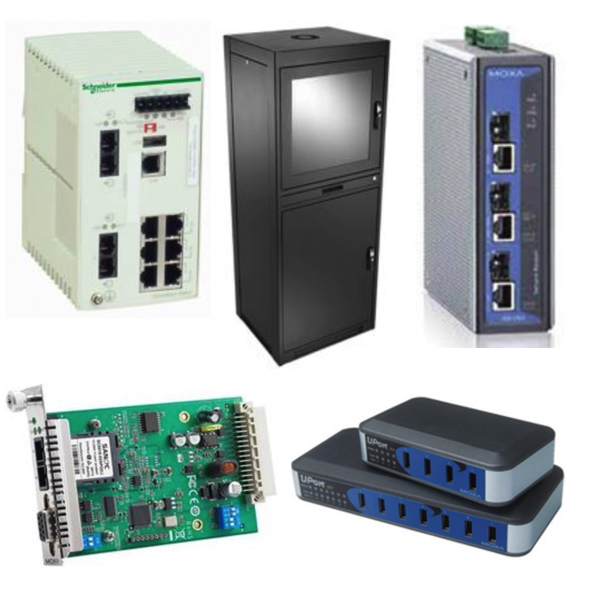Networking & Communication

Ethernet switches connect wired devices such as computers, servers and printers to a local area network using multiple ports. Ethernet switches provide a more robust performance over hubs because they can devote more bandwidth to certain ports rather than an even distribution between all ports.
Firewall routers most commonly connect local area networks to wide area networks with the added protection of monitoring the data and blocking incoming threats.
Serial device servers modify serial transmissions into Ethernet compatible signals so that they can used remotely by network connected applications. Serial devices will then be able to communicate over an IP-based network without disrupting the method used for communication.
Industrial modems and routers connect devices to local area networks and wide area networks with high-speed applications that transfer large amounts of data. These industrial-grade devices are made of robust materials that can withstand harsh environmental conditions.
More Information about Networking & Communication
Media converters are network devices that convert electrical signal in copper network cabling to light waves used for optic cabling. This allows two network devices to be connected across long distances and a smooth integration of new equipment into an existing cabling infrastructure.
Gateways act as a portal between two programs to communicate by converting the protocol of one device to a suitable protocol for the other device. This single point of access can provide safety and rapid data transmission.
Basics of Switches, Routers & Hubs
Ethernet hubs, switches and routers connect computers to networks, devices and other computers.
Ethernet hubs are the least intelligent of the three devices. They simply take any message that is received and transmits it to every other device connected to that hub. For example, if CPU 1 on a network wants to send a message to CPU 5, it will send that message through the hub.The hub will then take that message and send it out to every connected device on that hub regardless of the intended target. When CPU 5 receives that message and wants to respond, it will send its response through the hub which sends it to every connected device. Ethernet hubs do not manage any data that is sent and tend to bog down networks. They also do not offer much security for the network. For these reasons, Ethernet hubs are are being replaced with network switches.
Switches transmit data from one device to another on the same network. Unlike a hub, switches use a switch table to learn where data came from and where to send it. Switch tables store Mac addresses and device ports. By storing this data, a switch can operate more efficiently than a hub, greatly reducing the traffic within the network.
Routers transfer data between devices while learning the location of those devices within the network. They are also a junction between two or more networks. An example of this would be a home router where the home network is connected to the Internet. Another example would be when the router connects two or more networks with different business functions. In addition to connecting two or more networks, a router offers important security features that help protect the network.

